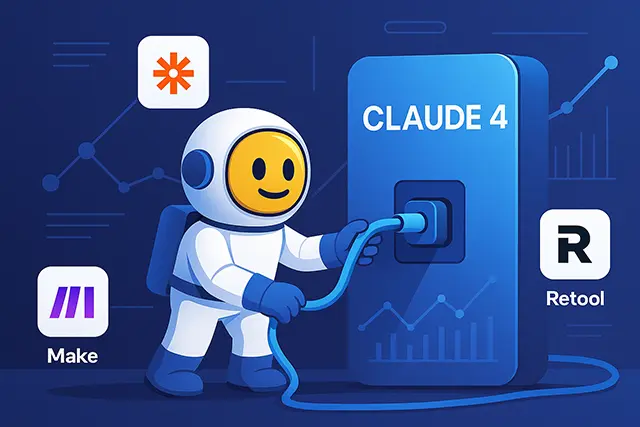How to Use Claude 4 for Business Automation Workflows

Claude 4 for Business Automation is rapidly becoming a cornerstone in enterprise AI strategy. As organizations rethink how to streamline their operations, Claude 4 emerges as a trusted solution for automating workflows, improving team productivity, and integrating intelligence into day-to-day business systems.
Claude 4 by Anthropic, we explained how the model’s architecture prioritizes reliability and transparency. These principles matter deeply to business leaders, especially in sectors like healthcare, finance, and customer support where errors are costly. With Claude 4, businesses are discovering a new way to operate one where AI doesn’t replace humans, but extends their capabilities.
Let’s dive into how Claude 4 is being applied across real-world enterprise workflows, from internal operations to content creation, from technical documentation to multilingual support.
Table of Contents
What Makes Claude 4 for Business Automation Different for Enterprise Use?
Claude 4 is not just another LLM; it was purpose-built for safe deployment in high-stakes environments. Its most significant differentiator is its Constitutional AI framework, a novel alignment method that teaches the model to reason based on a set of predefined principles. This leads to outputs that are more truthful, polite, and less prone to hallucination essential features when deploying AI across customer-facing or compliance-heavy domains.
Another strength lies in its token context window, capable of processing 100,000+ tokens. Businesses can feed Claude entire legal documents, product catalogs, or documentation libraries in a single pass something even GPT-4 often struggles to handle. Claude also has better interpretability and explanation capabilities, making it easier to justify decisions or outputs in regulated settings.
This combination of safety, scale, and control makes Claude 4 especially powerful when embedded in real workflows not just as a chatbot, but as a core reasoning engine for business systems.
Intelligent Customer Support That Builds Trust
Claude 4 is already making waves in the world of customer experience. By embedding it into helpdesk systems or CRM workflows, businesses can deliver real-time, empathetic, and consistent responses to customers at scale.
Unlike traditional bots that rely on predefined scripts, Claude adapts dynamically to user tone, context, and past conversations. For example, an e-commerce company can deploy Claude to handle 80% of tier-1 support tickets from refund requests to order status queries without frustrating users. Because Claude retains context and responds with natural language, customers often don’t realize they’re speaking with AI.
In our comparison of Claude 4 and GPT-4, we noted that Claude demonstrated fewer hallucinations and maintained better tone consistency across multiple rounds of interaction. That’s a critical edge in industries like fintech, insurance, or healthcare, where misunderstandings can have serious consequences.
Internal Workflow Automation with Claude 4 for Business Automation
Claude isn’t just useful externally it shines when embedded in internal tools. Operations teams, HR departments, and finance analysts waste countless hours navigating software and formatting data. With Claude, those tasks become conversational.
A logistics company might ask Claude, “Generate a weekly summary of late deliveries in the Jakarta region,” and receive a formatted report ready for email. HR teams can automate onboarding flows by asking Claude to generate customized training plans based on role and region. Even finance teams can prompt Claude to reconcile invoices, identify discrepancies, or format spreadsheet data all through natural language commands.
This automation isn’t just about speed it’s about accessibility. With Claude acting as a universal interface across disconnected systems, knowledge work becomes smoother and less siloed.
Executive Summarization and Business Insights
Modern executives face a constant flood of reports, slide decks, and status updates. Claude 4 helps them see the signal, not the noise.
Let’s say your CEO wants a synthesis of all customer feedback for the last quarter. Instead of manually reviewing NPS surveys, support transcripts, and reviews, Claude can generate a summary: “Customer satisfaction improved 12% in Q2, primarily due to faster support response times. However, product complaints rose among enterprise users.”
Claude’s large token window allows it to parse and analyze entire data dumps without breaking context. Its summarizations include nuance, sentiment detection, and even recommendation prompts perfect for board meetings or cross-functional planning.
As covered in our breakdown of Claude 4’s capabilities, this model doesn’t just summarize it strategizes.
Brand-Safe Content Generation
Content creation is a common use case for LLMs, but few are safe enough for brand-sensitive environments. Claude 4 changes that. Marketing teams can use it to draft landing pages, product descriptions, SEO articles, or internal training materials confident the model won’t go off-brand or inject risky language.
A healthtech company, for example, used Claude to write over 200 onboarding documents for different client segments. Because of Claude’s Constitutional AI foundation, the content remained professional, inclusive, and aligned with legal tone requirements.
And thanks to context retention, Claude can adapt content based on region, target persona, or campaign goals without having to retrain the model. It understands voice and tone the way a human copywriter would, making it a game-changer for content at scale.
Claude 4 + RAG Systems for Knowledge Retrieval
Retrieval-Augmented Generation (RAG) is a method where the AI model pulls relevant documents from a database before generating a response. Claude 4 is particularly effective in these systems.
In enterprise use, RAG + Claude enables employees to ask questions like, “What’s the latest compliance requirement for crypto transfers in EU markets?” and receive an accurate, cited answer pulled from internal policy documents, not web data.
Legal firms, audit departments, and even academic publishers are using Claude this way. It reduces risk, boosts efficiency, and ensures that generative outputs remain grounded in the company’s knowledge base.
In our Claude 4 vs GPT-4 analysis, Claude’s performance in retrieval-based setups proved superior in terms of factuality and tone stability.
Claude in Automation Platforms (Zapier, Make, Retool)
You don’t need to be a developer to embed Claude into workflows. Platforms like Zapier, Make, or Retool allow businesses to integrate Claude 4 as a reasoning engine inside visual workflows.
Here’s a real example: A SaaS startup built an onboarding automation using Claude. When a new user signs up, Claude generates a welcome email, configures help resources based on user role, and creates a follow-up task for the customer success team all in seconds.
Another use case involves social listening. Every time a user tweets negatively about a product, Claude categorizes the sentiment, drafts a response, and updates the CRM all triggered by Zapier.
This type of automation used to require developer time. Now, Claude makes it accessible to business ops and growth teams unlocking smarter systems without engineering overhead.
Claude 4 for Multilingual Support and Localization
Businesses operating in international markets face major language and cultural challenges. Claude 4 helps close this gap with multilingual fluency and cultural sensitivity.
Whether you’re translating contracts into Japanese or creating localized product copy for Brazil, Claude preserves meaning and tone. It avoids literal, robotic translations by understanding idioms, formality, and cultural context.
Customer support teams use Claude to handle inquiries in over 20 languages while maintaining SLAs. Marketing teams deploy Claude for region-specific campaigns without needing separate copywriters for each locale.
Its localization power is rooted in the same principles we discussed in Claude’s safe and ethical design: outputs are not just accurate, but responsible and respectful.
Technical Documentation and Engineering Use Cases
One of the most overlooked use cases for LLMs in business is technical documentation. Claude 4 excels here.
Software teams use Claude to convert release notes into structured docs. Product managers feed it Jira comments, and Claude returns complete product manuals. Even customer success reps use Claude to generate FAQs based on chat transcripts.
A fintech company even built a “Claude Docs Bot” that reads GitHub commits and updates API documentation accordingly. Because Claude can understand context across entire repos, changelogs, and user reports, the documentation is accurate, up-to-date, and aligned with product voice.
Unlike other models that require prompt engineering gymnastics, Claude just works especially for teams moving fast and scaling documentation needs.
Claude 4 for Regulated Industries
For industries like banking, healthcare, and public services, the risks of using LLMs are higher but so are the rewards. Claude 4 meets these sectors with the caution and control they demand.
In banking, it helps draft Know Your Customer (KYC) emails and onboarding flows that comply with regulatory language. In healthcare, it summarizes patient-facing documents without inserting medical advice. In public agencies, it rewrites government policies into plain-language guides for citizens.
This safety isn’t accidental it’s baked into Claude’s DNA. As described in our deep dive into Constitutional AI, Claude’s responses are vetted for neutrality, safety, and bias resistance. That makes it trustworthy in places where risk is unacceptable.
Should Your Business Adopt Claude 4?
If your organization deals with high volumes of text, multilingual operations, strict compliance needs, or internal complexity, Claude 4 is not optional it’s strategic. It reduces friction, saves time, and enhances the quality of both decisions and documents.
From support tickets to executive briefs, from code docs to cross-border contracts, Claude 4 operates as a reliable second brain. It integrates easily with your tools, adapts to your brand, and helps teams scale without adding headcount.
As you consider adoption, revisit our full guide on Claude 4’s architecture and real-world impact for a deeper look at its strengths.
Final Thoughts: From Cost Center to Competitive Advantage
Claude 4 isn’t a tool it’s infrastructure. For businesses embracing automation with responsibility and ambition, Claude is the foundation of a smarter operating system. It doesn’t just reduce cost it creates leverage.
And in today’s economy, that’s not just a nice-to-have. It’s a competitive edge.



